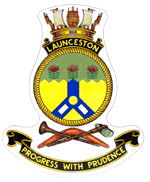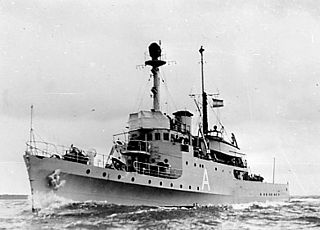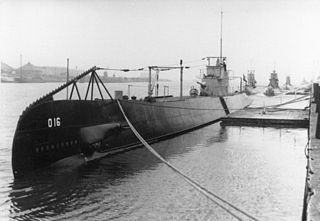
HMAS Quiberon (G81/D20/D281/F03) was a Q-class destroyer of the Royal Australian Navy (RAN). Although built for the Royal Navy and remaining British property until 1950, Quiberon was one of two Q-class destroyers commissioned into the RAN during World War II. She was passed into full RAN ownership in 1950, and converted into an anti-submarine frigate.

HMAS Burnie (J198/B238/A112), named for the city of Burnie, Tasmania, was one of 60 Bathurst class corvettes constructed during World War II and one of 20 built for the Admiralty but manned by personnel of and commissioned into the Royal Australian Navy (RAN).

HMAS Deloraine (J232/M232), named for the town of Deloraine, Tasmania, was one of 60 Bathurst-class corvettes constructed during World War II, and one of 36 initially manned and commissioned solely by the Royal Australian Navy (RAN). In January 1942 she evaded an attack by the Japanese submarine I-124 north-west of Darwin and was jointly credited with the submarine's sinking after inflicting the initial damage. She was present at the bombing of Darwin and survived unscathed.

HMAS Kalgoorlie (J192/B245/A119), named for the city of Kalgoorlie, was one of 60 Bathurst-class corvettes constructed during World War II and one of 20 built for the Admiralty but manned by personnel of and commissioned into the Royal Australian Navy (RAN).

The Bathurst-class corvettes were a class of general purpose vessels designed and built in Australia during World War II. Originally classified as minesweepers, but widely referred to as corvettes, the Bathurst-class vessels fulfilled a broad anti-submarine, anti-mine, and convoy escort role.

HNLMS Tromp was the lead ship of the Tromp-class destroyer leaders built for the Royal Netherlands Navy. Built just prior to World War II, the ship served mainly in the Pacific and Indian Oceans against the Japanese, being based out of Sydney, Fremantle and Trincomalee where she served alongside British, Australian and US warships. After the war, she returned to the Netherlands; after 1949, Tromp was used as a training and accommodation ship, before being decommissioned in 1955, and scrapped in 1969.

HMAS Hobart was a modified Leander-class light cruiser which served in the Royal Australian Navy (RAN) during World War II. Originally constructed for the Royal Navy as HMS Apollo, the ship entered service in 1936, and was sold to Australia two years later. During the war, Hobart was involved in the evacuation of British Somaliland in 1940, fought at the Battle of the Coral Sea and supported the amphibious landings at Guadalcanal and Tulagi in 1942. She was torpedoed by a Japanese submarine in 1943, then returned to service in 1945 and supported the landings at Tarakan, Wewak, Brunei, and Balikpapan. Hobart was placed in reserve in 1947, but plans to modernise her and return her to service as an aircraft carrier escort, training ship, or guided missile ship were not followed through. The cruiser was sold for scrapping in 1962.

HMAS Canberra (I33/D33), named after the Australian capital city of Canberra, was a Royal Australian Navy (RAN) heavy cruiser of the Kent sub-class of County-class cruisers. Constructed in Scotland during the mid-1920s, the ship was commissioned in 1928, and spent the first part of her career primarily operating in Australian waters, with some deployments to the China Station.

Fubuki was the lead ship of twenty-four Fubuki-class destroyers, built for the Imperial Japanese Navy following World War I. When introduced into service, these ships were the most powerful destroyers in the world. They served as first-line destroyers through the 1930s, and remained formidable weapons systems well into the Pacific War. Fubuki was a veteran of many of the major battles of the first year of the war, and was sunk in Ironbottom Sound during the Battle of Cape Esperance in World War II.

The first HMAS Bendigo (J187/B237/A111) was a Bathurst-class minesweeper, a group commonly known as corvettes and including escort and patrol duties along with minesweeping.

HMAS Armidale (J240), named for the then town of Armidale, New South Wales, was one of 60 Bathurst-class corvettes constructed during World War II, and one of 36 initially manned and commissioned solely by the Royal Australian Navy (RAN).

HMAS Yarra (U77), named for the Yarra River, was a Grimsby-class sloop of the Royal Australian Navy (RAN) that served during World War II. Commissioned in 1936, Yarra spent the early part of the war in Australian waters, then was transferred to the East Indies Station in 1940. The sloop operated in the Red Sea, then was involved in the Anglo-Iraqi War and the Anglo-Soviet invasion of Iran. After operating as part of the Tobruk Ferry Service in the Mediterranean during November, Yarra was reassigned to Southeast Asia in response to Japanese attacks. On 4 March 1942, Yarra was attacked and sunk by a force of Japanese cruisers and destroyers while attempting to protect ships withdrawing to Australia.

HMAS Wollongong (J172), named for the city of Wollongong, New South Wales, was one of 60 Bathurst-class corvettes constructed during World War II and one of 20 built for the Admiralty but manned by personnel of and commissioned into the Royal Australian Navy (RAN).

HMAS Gawler (J188/B241/A115), named for the town of Gawler, was one of 60 Bathurst-class corvettes constructed during World War II and one of 20 built for the Admiralty but manned by personnel of and commissioned into the Royal Australian Navy (RAN). The ship was laid down by BHP at its Whyalla shipyard in early 1941, launched later that year, and commissioned in 1942.

HMAS Launceston (J179/B246/A120), named for the city of Launceston, Tasmania, was one of 60 Bathurst-class corvettes constructed during World War II and one of 20 built for the Admiralty but manned by personnel of and commissioned into the Royal Australian Navy (RAN).

HMAS Toowoomba (J157/B251/A125), named for the city of Toowoomba, Queensland was one of 60 Bathurst-class corvettes constructed during World War II and one of 20 built on Admiralty order but manned by personnel of and later commissioned into the Royal Australian Navy (RAN). The ship later served in the Royal Netherlands Navy (RNN) as HNLMS Boeroe.

The Jan van Amstel class was a class of nine minesweepers of the Royal Netherlands Navy, built to serve in the Dutch East Indies and Dutch territorial waters in Europe. The class was originally planned to consist of 12 ships, but because of the German occupation of the Netherlands in the Second World War, three of the four ships that were still under construction were never completed.
HNLMS K XI was the first of three K XI-class submarines of the Royal Netherlands Navy, built to serve as a patrol vessel in the Dutch colonies.

HNLMS O 16 was a submarine of the Royal Netherlands Navy that saw service during World War II. She was the first submarine of the RNN manufactured from high-quality Steel 52, with the ability to dive at a depth of 80 metres (260 ft).

HNLMS Onverschrokken (A856), also known as HNLMS Mercuur (A856), was an Onversaagd-class minesweeper of the Royal Netherlands Navy (RNN). Soon after being taken into service of the RNN, the ship was put into reserve alongside the rest of the minesweepers of the Onversaagd class. Later, in 1973 she was renamed as HNLMS Mercuur (A856) and used as submarine support ship till her decommissioning in 1987. Nowadays, she is a museum ship that can be visited in Vlissingen.






















